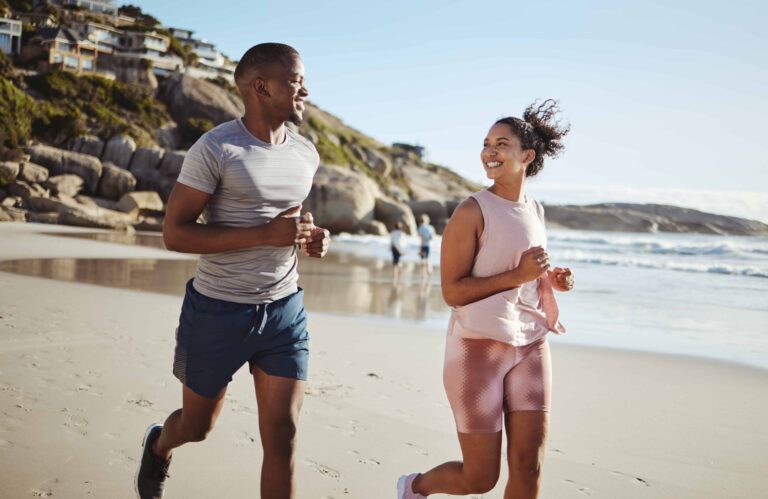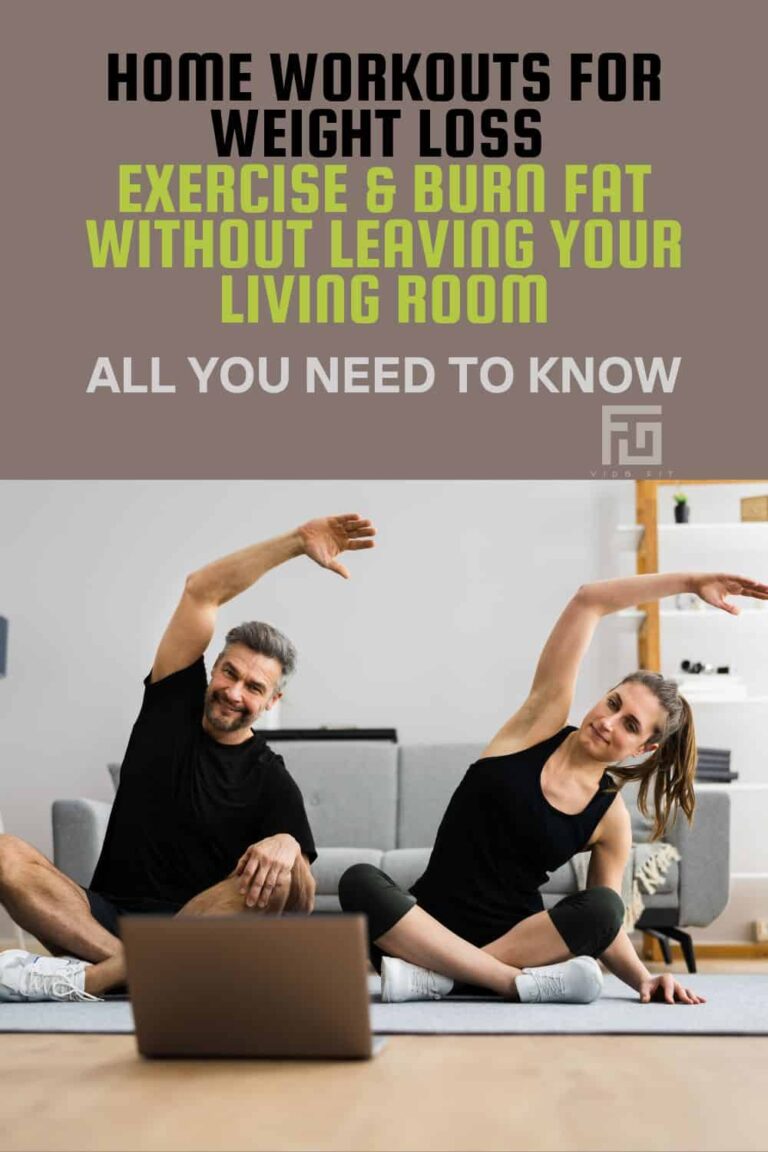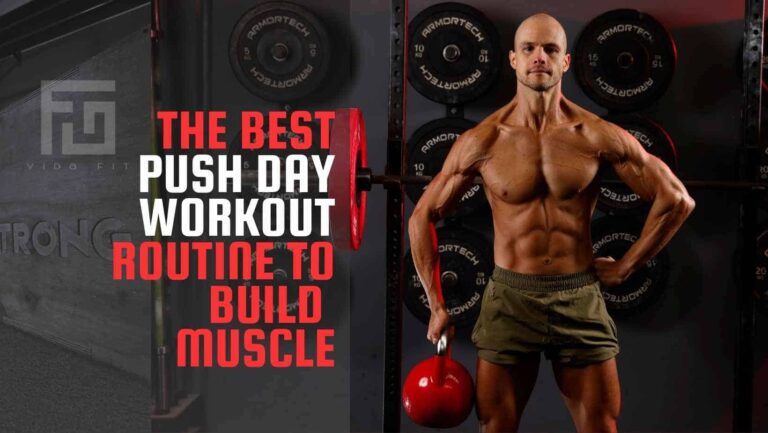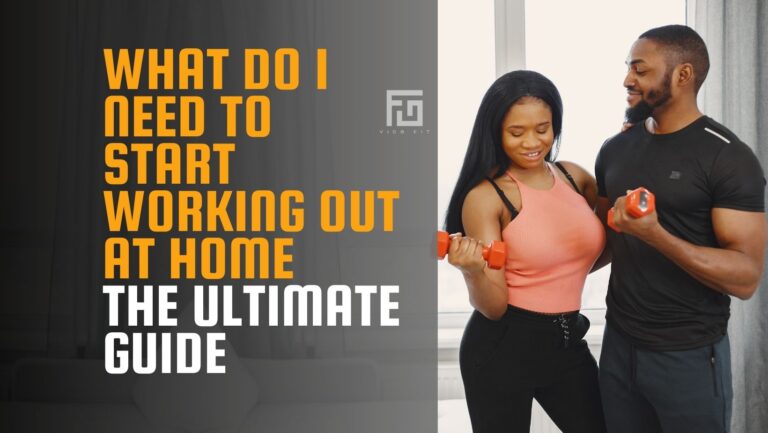How To Start Working Out At Home For Beginners | The Simple & Easy Way
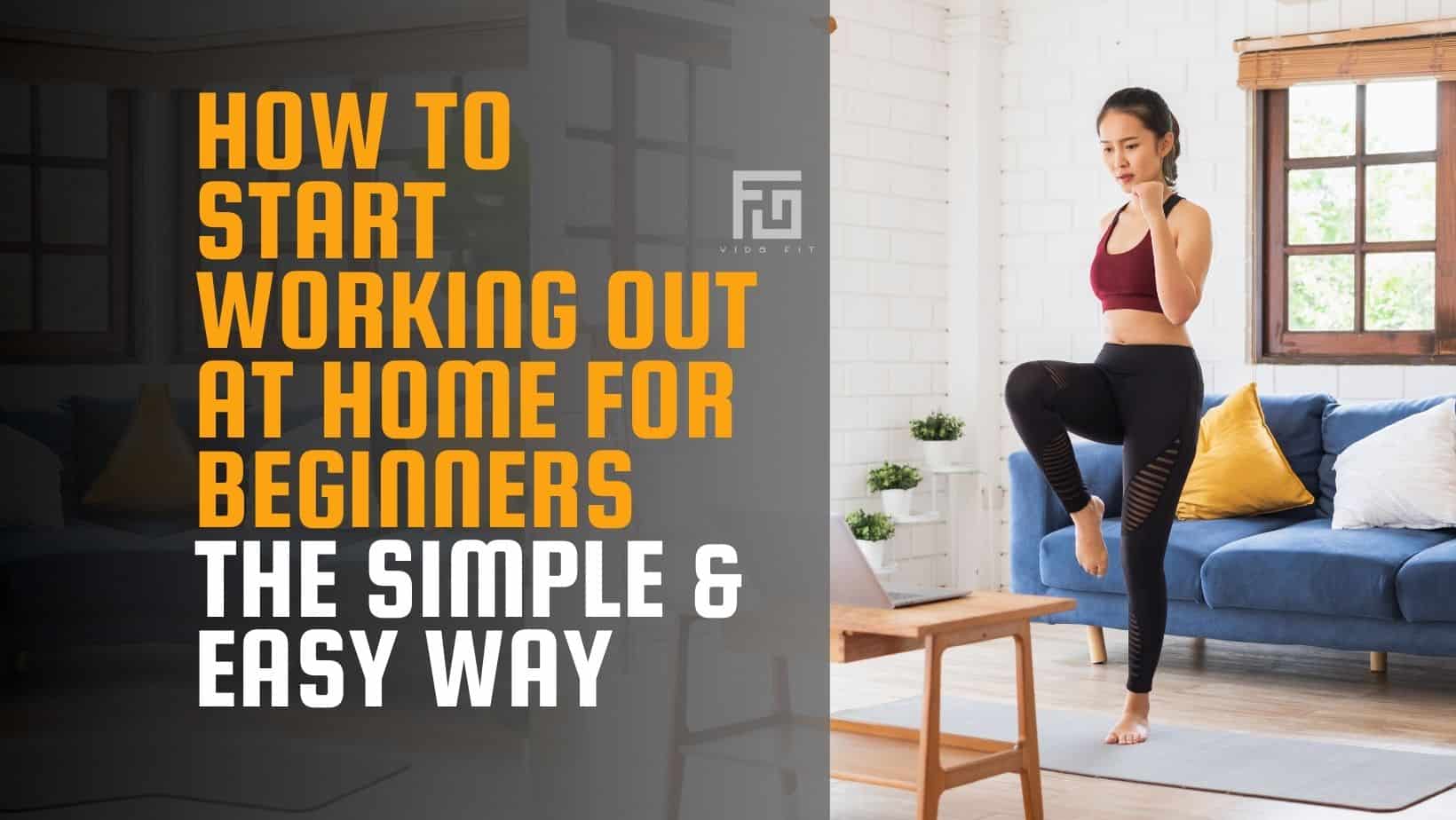
Are you ready to start exercising but don’t want to hit the gym?
Good news: you don’t have to! Working out at home can be simple, effective, and fun.
Imagine transforming your living room into a fitness hub.
No expensive equipment needed, no travel time—just you and your determination.
We’ll show you how to set up a routine that fits your lifestyle, ensuring you stay motivated and see results.
Dive into our guide and discover the easy steps to start your at-home workout today!
Table of Contents
How to Start Working Out at Home for Beginners
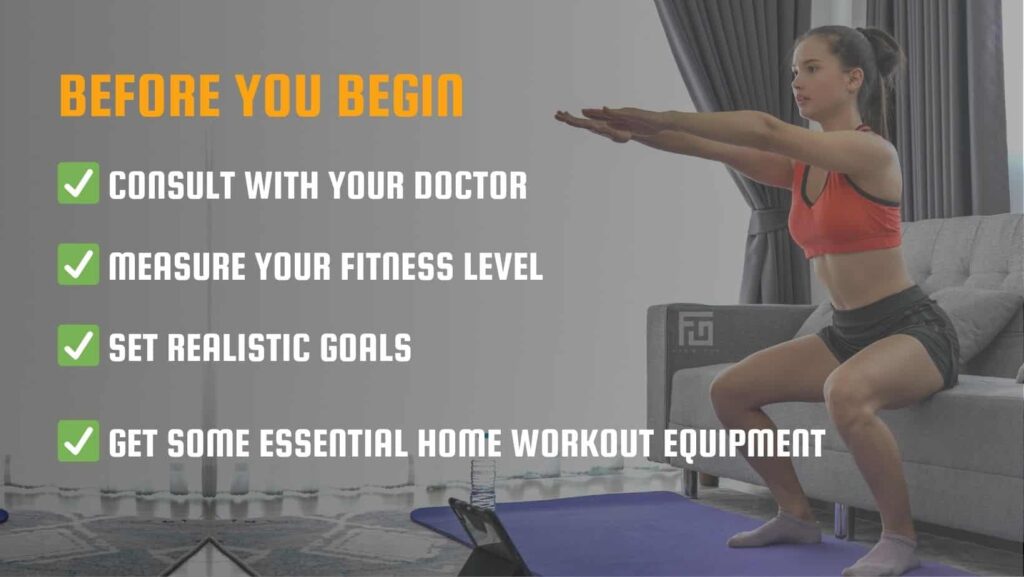
You’re ready to start your fitness journey. Before you dive in, setting up some key steps is crucial for success and safety.
▶️ Consult Your Doctor
Consulting your doctor is vital, especially if you’re new to working out. Your doctor can help make sure you know any health risks or limits. It’s even more important when exercising at home on your own. Your doctor can give advice to prevent injuries and keep you safe.
▶️ Measure Your Fitness Level
Before starting your at-home workout routine, it’s important to understand your current fitness level. Here’s a simple way to measure it:
- ✅ Resting Heart Rate:
- How to Measure: Count your pulse for 60 seconds while at rest.
- Normal Range: 60-100 beats per minute (bpm).
- Remember to get professional advice from your doctor.
- ✅ Push-Up Test:
- How to Measure: Perform as many push-ups as you can without stopping.
- ✅ Sit-and-Reach Test:
- How to Measure: Sit with your legs straight and reach forward as far as possible.
- Fitness Indicator: Gives you a sense of how flexible you currently are and how it improves over time. Measure the distance from your fingertips to your toes.
- ✅ 1-Mile Walk Test:
- How to Measure: Walk a mile as quickly as possible and record your time and heart rate.
- Fitness Indicator: Track timing improvements over time.
- ✅ Body Composition:
- How to Measure: Use a scale or tape measure to track weight, BMI, and body fat percentage.
- Fitness Indicator: Track changes over time for improvement.
Use these simple tests to set a baseline and track progress as you start your at-home workout journey.
▶️ Set Realistic Goals
- Start Small: Set achievable goals like working out for 10 minutes a day.
- Be Specific: Define clear objectives, e.g., “Do 20 squats daily.”
- Set Measurable Goals: Track progress with numbers, like losing 5 pounds in a month.
- Focus on Consistency:Aim to exercise regularly, not perfectly.
- Create a Schedule:Plan workouts for specific days and times.
- Mix It Up:Incorporate different exercises to stay engaged.
- Listen to Your Body:Avoid overtraining; rest when needed.
- Celebrate Milestones:Reward yourself for reaching small goals.
- Stay Flexible: Adjust goals as you progress.
- Seek Support: Join online communities for motivation and tips.
By setting realistic and achievable goals, you can maintain motivation and track your progress effectively as you start your at-home workout journey.
▶️ Essential Home Workout Equipment
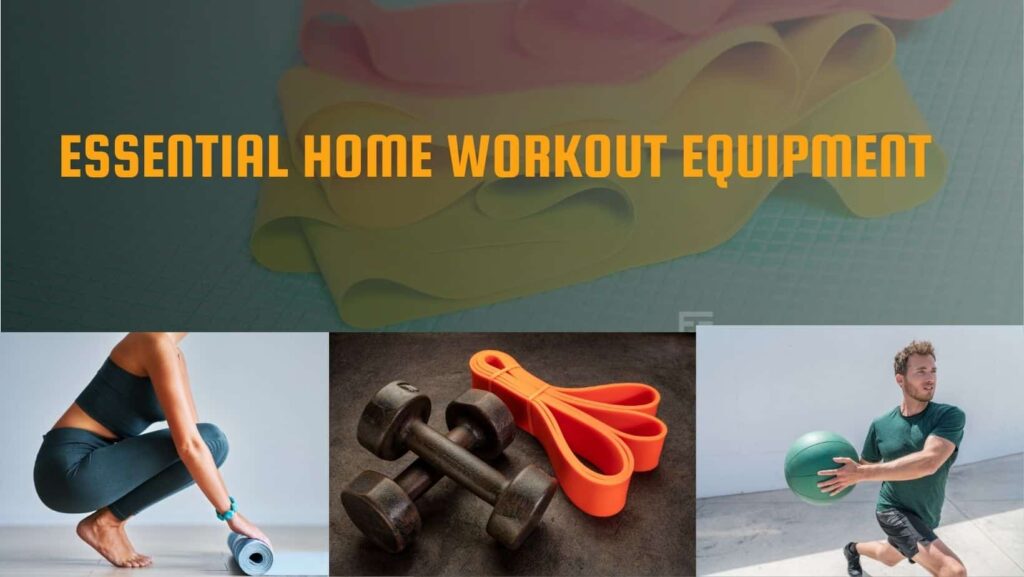
Creating your home gym is easier and cheaper than you might think. You can transform any space into a place to exercise and achieve your fitness goals. Start with these four key pieces of gear:
🧘 Yoga Mat
A high-quality yoga mat is key for home fitness. It adds comfort and safety for many exercises. It’s great for stretching, yoga, and strength workouts.
💪 Resistance Bands
Resistance bands are cheap and work for many exercises. They let you add strength workouts to your day at home. With different levels of resistance, you can challenge all your muscles. Using a door mount system, like Bodylastics offers, gives you more ways to use them. It may also help you to build muscle faster.
🏋️ Adjustable Dumbbells
Adjustable dumbbells, such as those by Powerblock or Bowflex, are perfect for weight training at home. They save space and make it easy to change the weight. For storage, a dumbbell rack is a smart choice.
⚖️ Stability Ball
A stability ball can be a great addition to your at-home workouts. It’s great for the core, and balance and even acts as a desk chair. It adds variety to your exercises and helps improve your overall fitness.
| Essential Equipment | Benefits |
| Yoga Mat | Comfort and stability for various exercises |
| Resistance Bands | Versatile, cost-effective for strength training |
| Adjustable Dumbbells | Quick weight adjustments for tailored workouts |
| Stability Ball | Improves core stability and balance |
At-Home Workouts
If you are looking for quick and easy workouts, check out this post that includes more than 10 at-home super easy workouts.
But, if you are looking for a more structured exercise program to start working out at home for beginners, make sure you check out the FREE 12-WEEK WORKOUT PROGRAMS FOR BEGINNERS.
Aerobic Exercise Ideas To Start Working Out At Home For Beginners
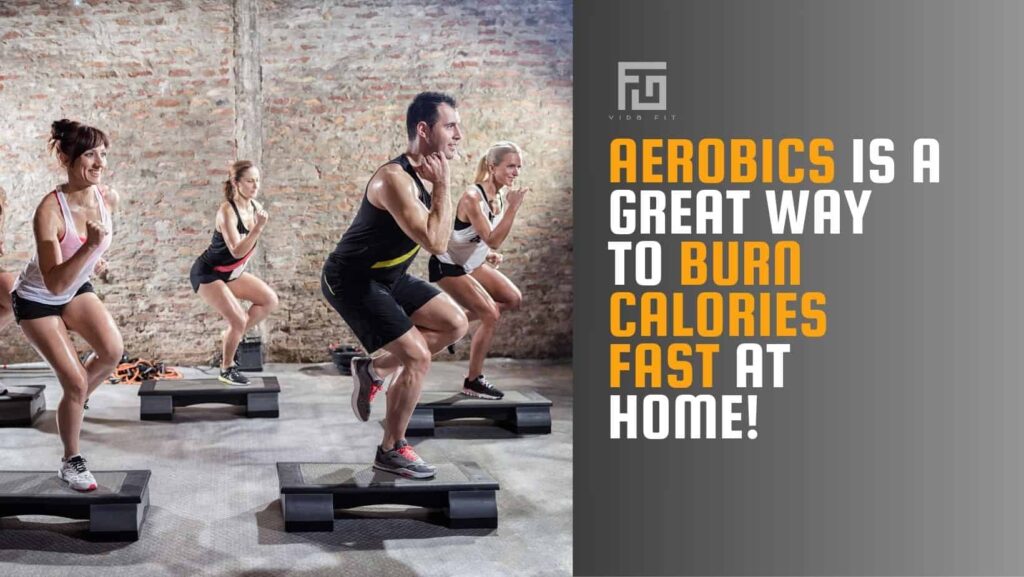
Aerobic exercises, also known as cardio, are great for improving heart health, burning calories, and increasing stamina. They can be easily performed at home, depending on the equipment on the equipment you have available.
Here are some beginner-friendly aerobic workouts to get you started:
- Walking or Jogging in Place: Simple and effective, perfect for beginners.
- Dancing: Put on your favorite music and dance for a fun workout.
- Step Aerobics: Use a sturdy step or bench to step up and down.
- Jump Rope: Great for cardiovascular fitness and coordination.
- Cycling: Use a stationary bike if you have one at home.
Incorporating these aerobic exercises into your routine can help you improve your cardiovascular health and overall fitness. Start with short sessions and gradually increase the duration as you build your stamina.
You can move on to more vigorous exercises when you are ready. There is no need to rush the process.
Warm-Up and Cool-Down Techniques
Adding good warm-up and cool-down methods to your workouts is crucial. They help boost your performance while reducing the chance of getting hurt. They also get your body ready for the workout ahead and help it calm down afterward.
✅ Importance of Warm-Up
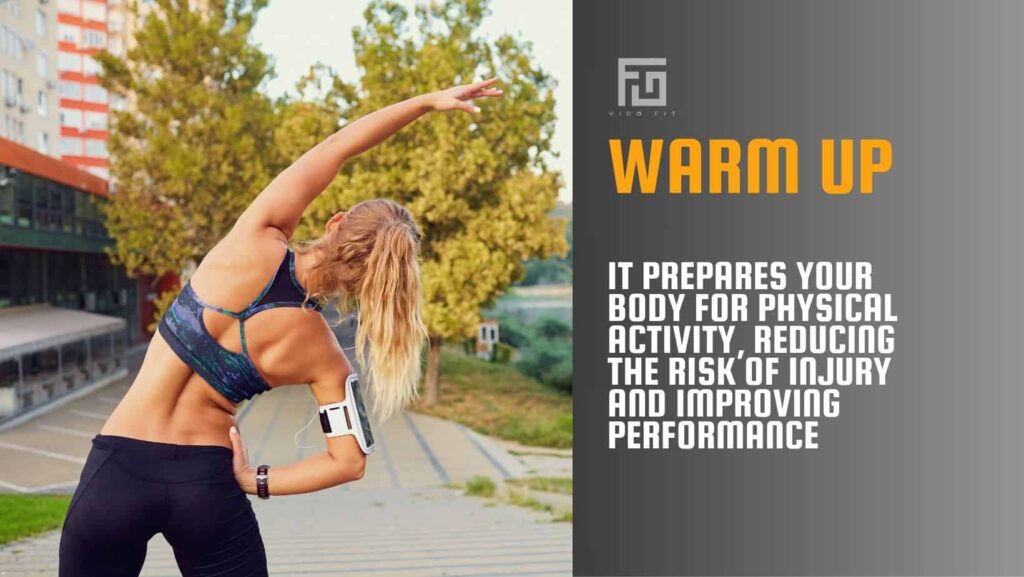
Warming up is crucial before starting any workout. It prepares your body for physical activity, reducing the risk of injury and improving performance. Here’s why warming up is essential:
- Increases Heart Rate: It gradually raises your heart rate, preparing your cardiovascular system for exercise.
- Boosts Blood Flow: Enhances blood flow to muscles, ensuring they receive more oxygen and nutrients.
- Improves Flexibility: Makes muscles more pliable and joints more flexible, reducing the risk of strains and sprains.
- Raises Body Temperature: Warmer muscles are more efficient and less prone to injury.
- Enhances Muscle Function: Prepares muscles for the upcoming activity, improving strength and coordination.
- Mental Preparation: Helps you mentally transition from rest to exercise, improving focus and performance.
✅ Effective Warm-Up Exercises
- Arm Swings: Swing your arms in circles to loosen shoulder muscles.
- Leg Kicks: Perform controlled leg kicks to stretch and activate leg muscles.
- Light Jogging: Jog lightly in place or around your space to raise your heart rate.
- Dynamic Stretches: Incorporate dynamic stretches like lunges and torso twists to engage multiple muscle groups.
- Jumping Jacks: A full-body warm-up that gets your blood pumping.
✅ Benefits of a Good Warm-Up
- Prevents Injuries: Reduces the likelihood of muscle strains and joint injuries.
- Enhances Performance: Optimizes muscle function and prepares your body for intense exercise.
- Improves Range of Motion: Increases flexibility, making movements more efficient.
Taking a few minutes to warm up can make a significant difference in your workout effectiveness and safety. Make it a habit to always start your exercise routine with a proper warm-up.
A Word or Two on Cooling Down After Working Out
After your workout, transitioning into a cool-down is crucial for your body. This phase helps lower your heart rate and blood pressure gradually, aiding recovery and preventing injury.
- Gradually Lowers Heart Rate: Moving from intense activity to a slower pace helps your heart rate and blood pressure return to normal.
- Reduces Muscle Soreness:A proper cool-down can help reduce the buildup of lactic acid in your muscles, minimizing soreness.
- Improves Flexibility:Stretching post-exercise helps maintain and improve your flexibility.
✅ Cool-Down Activities
- Light Walking
– Duration: 5-10 minutes
– Benefits: Helps to gradually reduce your heart rate and relaxes your muscles. - Stretching
– Duration: 5-10 minutes
– Benefits: Focus on major muscle groups, holding each stretch for 15-30 seconds. This helps improve flexibility and reduce muscle stiffness. - Upper Body Stretches
– Shoulder Stretch: Bring one arm across your body and use the other arm to pull it closer.
– Triceps Stretch: Raise one arm overhead, bend the elbow, and use the opposite hand to push the elbow down gently. - Lower Body Stretches
– Quad Stretch: Stand on one leg, pull your other foot toward your glutes, and hold.
– Hamstring Stretch: Sit with one leg extended and reach for your toes, keeping your back straight. - Full Body Stretch
– Cat-Cow Stretch: Get on all fours, arch your back up (cat), then dip it down (cow) for a complete spine stretch.
✅ Importance of Consistent Cool-Downs

– Aids Recovery: Ensures your muscles recover faster and with less soreness.
– Prevents Injuries: Helps to prevent stiffness and injuries by maintaining flexibility.
– Enhances Performance: Regular cool-downs improve your overall workout performance by preparing your body for the next session.
Make these cool-down sessions an integral part of your workout routine. After cooling down, you’ll get a sense of really completing your workout, leaving you relaxed after all the tension applied during the workout.
Nutrition Tips For Beginners Who Want To Start Working Out At Home

1. Stay Hydrated
The recommended daily water intake for people who exercise varies based on several factors, including gender, activity level, and environmental conditions. Here are the general guidelines:
Baseline Daily Intake:
- For men: 3.7 liters (approximately 125-130 ounces or 16 cups) per day.
- For women: 2.7 liters (approximately 91-95 ounces or 12 cups) per day
Pre-Exercise Hydration:
- Drink 17-20 ounces of water 2-3 hours before exercise.
- Drink an additional 8 ounces of water 20-30 minutes before exercising or during warm-up.
During Exercise:
- Drink 7-10 ounces of water every 10-20 minutes during exercise.
Post-Exercise Hydration:
- Drink 16-24 ounces of water for every pound of body weight lost after exercise.
Additional Considerations:
- For exercise lasting longer than an hour, especially in hot conditions, a sports drink may be beneficial to replace lost electrolytes.
- Monitoring urine color can help gauge hydration status; pale yellow indicates good hydration, while dark yellow suggests the need for more fluids.
2. Balance Your Plate
Include a mix of protein, carbs, and healthy fats in each meal.
3. Eat Whole Foods
80% of the time, choose whole grains, fruits, vegetables, and lean proteins over processed foods.
4. Portion Control
Be mindful of portion sizes to avoid overeating.
5. Snack Smart
Opt for healthy snacks like nuts, fruits, and yogurt.
6. Limit Sugar
Reduce intake of sugary drinks and snacks.
7. Plan Your Meals
Prepare meals ahead of time to ensure balanced nutrition.
8. Read Labels
Check food labels for nutritional information and avoid high-sodium or high-sugar items. If you have two products side by side, try to choose the option with lower calories.
9. Don’t drink your calories
Soft drinks, like a normal can of cola, can contain over 100 calories each. Select the sugar-free version, which contains virtually no calories. This is why reading the labels is so important.
10. Listen to Your Body
Eat when you’re hungry, and stop when you’re full.
Benefits Of Exercising At Home
Home workouts are a great way to stay fit. They save time and money since you don’t need to go to the gym, making it easier to exercise regularly, even if you’re very busy.
✅ Convenience
Home workouts save time and hassle by eliminating the need to commute to the gym. You can fit them into your schedule whenever it’s most convenient, whether early in the morning or late at night.
✅ Cost-Effective
Working out at home is budget-friendly. There’s no need for expensive gym memberships or fancy equipment. You can use household items or inexpensive gear like resistance bands and yoga mats.
✅ Flexibility
Home workouts offer the flexibility to tailor your routine to your needs. You can choose exercises that suit your fitness level and goal and easily adjust the intensity as you progress.
✅ Privacy
Exercising at home provides a comfortable and private environment. You can work out without feeling self-conscious, which is especially beneficial for beginners who might feel intimidated at the gym.
✅ Safety
By working out at home, you can control your environment to ensure safety. You can avoid crowded gym spaces and reduce the risk of injury by following proper techniques and using familiar equipment.
Wrapping Up

Starting your fitness journey at home is simple and effective with the right approach. Here’s a quick recap of the key points:
- Consult Your Doctor: Ensure you’re ready to begin.
- Measure Your Fitness Level: Use easy tests like resting heart rate and push-ups.
- Set Realistic Goals: Start small, be specific, and stay consistent.
- Essential Equipment: Invest in a yoga mat, resistance bands, adjustable dumbbells, and a stability ball.
- Aerobic Exercises: Try walking, dancing, step aerobics, jump rope, and cycling.
- Warm-Up: Boosts blood flow, improves flexibility, and prevents injuries.
- Cool-Down: Reduces soreness, lowers heart rate, and enhances recovery.
- Nutrition Tips: Stay hydrated, balance your plate, and eat whole foods.
By following these steps, you’ll set a solid foundation for your at-home workouts. Remember, consistency is key, and with time, you’ll see great results. Keep motivated, stay flexible with your goals, and enjoy the process of becoming fitter and healthier from the comfort of your home!
References
- https://www.healthline.com/nutrition/how-to-start-exercising
- https://www.nerdfitness.com/blog/the-7-best-at-home-workout-routines-the-ultimate-guide-for-training-without-a-gym/
- https://www.everydayhealth.com/fitness/everything-you-need-to-know-about-working-out-at-home/
- https://www.healthline.com/health/exercise-fitness/strength-training-at-home
- https://www.healthline.com/health/fitness-exercise/at-home-workouts
- https://www.mayoclinic.org/healthy-lifestyle/fitness/in-depth/fitness/art-20048269
- https://scottabelfitness.com/building-your-own-home-gym/
- https://www.garagegymreviews.com/best-home-exercise-equipment-for-beginners
- https://health.clevelandclinic.org/best-home-gym
- https://www.nerdfitness.com/blog/beginner-body-weight-workout-burn-fat-build-muscle/
- https://greatist.com/fitness/15-minute-full-body-workout
- https://www.verywellfit.com/6-weeks-to-fitness-for-absolute-beginners-week-2-1230930
- https://www.health.com/fitness/workout-schedule
- https://www.mayoclinic.org/healthy-lifestyle/fitness/in-depth/exercise/art-20045517
- https://www.healthline.com/health/exercise-fitness/how-to-motivate-yourself-to-workout
- https://www.gaiam.com/blogs/discover/5-ways-to-stay-motivated-to-exercise-regularly
- https://www.muscleandfitness.com/nutrition/healthy-eating/ultimate-diet-plan-beginners/
